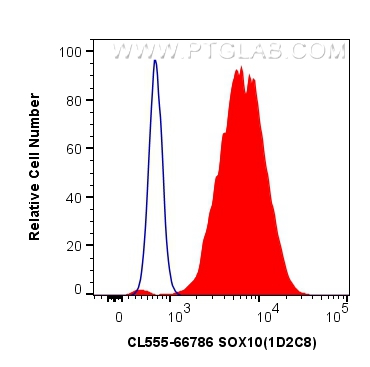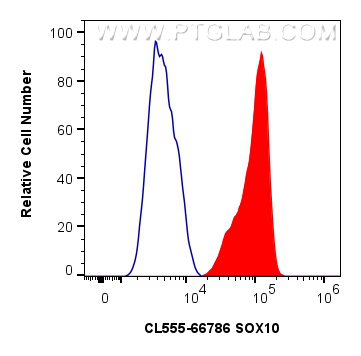验证数据展示
经过测试的应用
| Positive FC (Intra) detected in | C6 cells, A375 cells |
推荐稀释比
| 应用 | 推荐稀释比 |
|---|---|
| Flow Cytometry (FC) (INTRA) | FC (INTRA) : 0.40 ug per 10^6 cells in a 100 µl suspension |
| It is recommended that this reagent should be titrated in each testing system to obtain optimal results. | |
| Sample-dependent, Check data in validation data gallery. | |
产品信息
CL555-66786 targets SOX10 in FC (Intra) applications and shows reactivity with human, mouse, rat samples.
| 经测试应用 | FC (Intra) Application Description |
| 经测试反应性 | human, mouse, rat |
| 免疫原 | SOX10 fusion protein Ag23191 种属同源性预测 |
| 宿主/亚型 | Mouse / IgG2a |
| 抗体类别 | Monoclonal |
| 产品类型 | Antibody |
| 全称 | SRY (sex determining region Y)-box 10 |
| 别名 | 1D2C8, DOM, PCWH, SRY-box transcription factor 9, Transcription factor SOX 10 |
| 计算分子量 | 50 kDa |
| 观测分子量 | 55-60 kDa |
| GenBank蛋白编号 | BC002824 |
| 基因名称 | SOX10 |
| Gene ID (NCBI) | 6663 |
| RRID | AB_2934678 |
| 偶联类型 | CoraLite®555 Fluorescent Dye |
| 最大激发/发射波长 | 557 nm / 570 nm |
| 形式 | Liquid |
| 纯化方式 | Protein A purification |
| UNIPROT ID | P56693 |
| 储存缓冲液 | PBS with 50% glycerol, 0.05% Proclin300, 0.5% BSA , pH 7.3 |
| 储存条件 | Store at -20°C. Avoid exposure to light. Stable for one year after shipment. Aliquoting is unnecessary for -20oC storage. |
背景介绍
Sox10 is a transcription factor that has a crucial role in complex signalling pathways regulating central nervous system and neural crest development. The calcualted molecular weight of SOX10 is 50 kDa, but modified SOX10 is about 55-60 kDa. (PMID: 23799842)
实验方案
| Product Specific Protocols | |
|---|---|
| FC protocol for CL555 SOX10 antibody CL555-66786 | Download protocol |
| Standard Protocols | |
|---|---|
| Click here to view our Standard Protocols |

